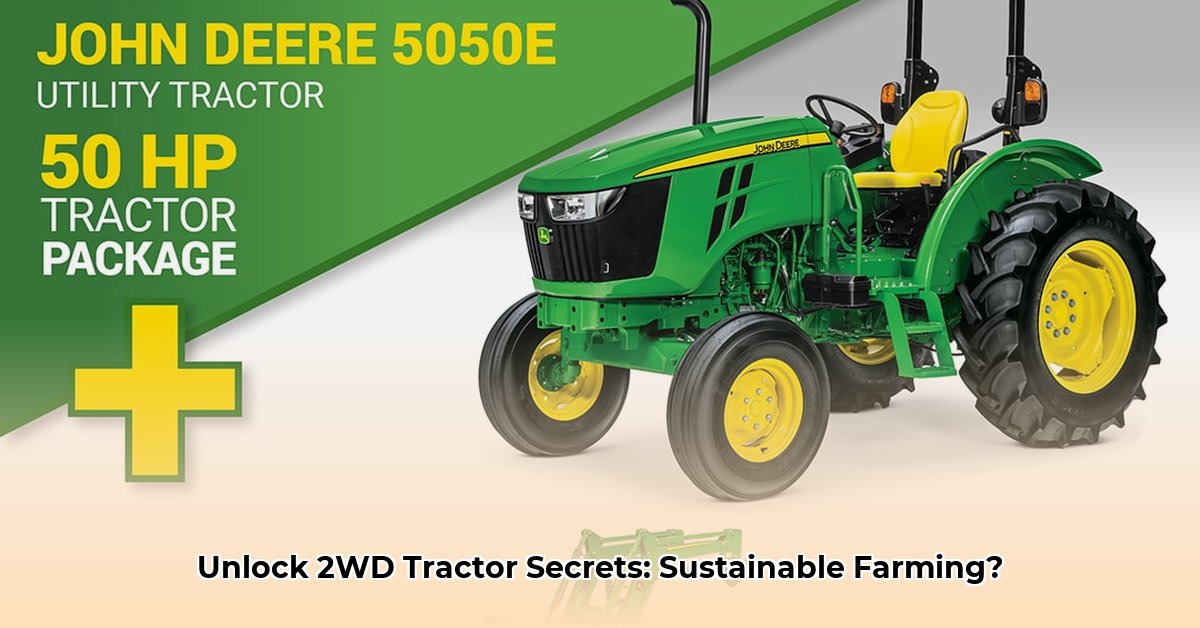
2WD Tractors: The Sustainable Farming Workhorse
Choosing the right equipment is paramount for any farmer striving for efficiency and sustainability. Often overlooked, the 2WD tractor presents a compelling option, especially for smaller farms or those prioritizing environmentally conscious practices. This guide explores the advantages of 2WD tractors within a sustainable agriculture framework, providing actionable advice for maximizing their effectiveness and minimizing environmental impact. Aren't fuel efficiency and reduced emissions key goals for modern farming? For more information on older, smaller tractors, check out this helpful resource.
Selecting Your Ideal 2WD Tractor: Power, PTO, and Fuel Efficiency
Before embarking on your tractor search, carefully consider your farm's acreage and the typical tasks you'll undertake. 2WD tractors excel in maneuverability, making them ideal for smaller farms and navigating tight spaces between rows. However, accurately assessing your horsepower needs is critical. Underpowering leads to inefficiency, while overspending on horsepower leads to unnecessary fuel consumption and increased costs.
A Power Take-Off (PTO) – essentially your tractor's power outlet – is crucial for operating implements like tillers, planters, and balers. Prioritize fuel efficiency; models with lower fuel consumption translate directly into cost savings and a smaller carbon footprint. Finally, ensure compatibility with sustainable implements like no-till seed drills or precision fertilizer spreaders.
Maximizing 2WD Tractor Efficiency: Sustainable Farming Techniques
Efficient tractor operation is integral to sustainable agriculture. Proper tire pressure is vital; maintaining optimal pressure minimizes soil compaction, preserving soil health, and improving water retention – essential for long-term soil fertility. Isn't this a cost-effective approach to maintaining soil health?
Gear selection significantly impacts fuel economy. Selecting the right gear avoids engine strain and reduces RPMs, optimizing fuel consumption and extending the tractor's lifespan. Overloading your tractor is detrimental; it reduces efficiency, increases fuel consumption, and risks costly mechanical damage. According to a 2023 study by the USDA, proper gear selection can improve fuel efficiency by up to 15%.
Sustainable Implements for Optimized Results
The choice of implements is as crucial as the tractor itself. No-till seed drills minimize soil disturbance, preserving soil structure and reducing erosion. Precision fertilizer spreaders enable targeted application, reducing fertilizer waste, lowering costs, and minimizing environmental impact. Did you know that precision fertilization can lead to a 30% reduction in fertilizer use? Research implements compatible with your specific 2WD tractor model to ensure optimal performance and integration.
Maintaining Your 2WD Tractor: A Simple Checklist for Longevity
Regular maintenance is an investment in your tractor's longevity and your farm's profitability. This simple checklist helps ensure peak performance for years to come:
- Regular Oil Changes: Follow the manufacturer's recommendations for oil type and change intervals.
- Filter Inspections: Regularly inspect and replace air, fuel, and oil filters to maintain optimal engine performance.
- Fluid Levels: Check and maintain correct coolant, hydraulic fluid, and transmission fluid levels. Low fluid levels can seriously damage components.
- Tire Pressure: Maintain the correct tire pressure based on the manufacturer's guidelines for both efficiency and safety.
- Regular Inspections: Conduct routine visual checks for signs of wear, tear, or damage to prevent minor issues from becoming major problems.
“Regular maintenance isn't just about avoiding breakdowns; it's about maximizing the lifespan and resale value of your equipment,” says Dr. Emily Carter, Agricultural Engineering Professor at Cornell University.
2WD vs. Larger Tractors: A Comparative Overview
| Feature | 2WD Tractor | Larger Tractors |
|---|---|---|
| Initial Cost | Lower | Significantly Higher |
| Fuel Efficiency | Generally Higher | Generally Lower |
| Maneuverability | Excellent, ideal for smaller fields and tighter spaces | Less maneuverable, can struggle in confined areas |
| Maintenance Cost | Lower | Higher |
| Environmental Impact | Lower emissions and fuel consumption | Higher emissions and fuel consumption |
| Versatility | Suitable for diverse tasks but might require more time for very large-scale operations | Better suited for large-scale operations |
While larger tractors offer greater power, 2WD tractors offer a sustainable and cost-effective alternative for many farms, excelling in fuel efficiency, maneuverability, and reduced environmental impact. The optimal choice depends on your farm's size and specific needs.
Calculating Precision Farming ROI for Small Farms
Precision farming techniques, though initially more expensive, can greatly enhance profitability on small farms through better resource management and yield optimization. The key is strategic planning to select technology that aligns with specific needs and budget constraints.
Accessing the Potential of Precision Farming for Small Farms
Precision farming is not solely for large-scale operations. By analyzing current farming practices, identifying cost areas, and selecting appropriate technologies (like variable rate application or precision irrigation), small farms can optimize resource use, reduce waste and boost profits. Isn't minimizing waste crucial for sustainable farming?
“Precision farming allows you to address your farm’s unique challenges and optimize inputs, making it very effective for small operations,” explains John Miller, owner of Miller Family Farms.
Choosing the Right Technology: A Step-by-Step Approach
Calculating the ROI for precision farming involves a systematic process:
- Calculate Initial Investment: Include the cost of hardware, software, and training.
- Estimate Annual Operating Costs: Factor in maintenance, repairs, data subscriptions, and labor.
- Quantify Cost Savings and Increased Revenue: Assess savings from reduced fertilizer or water use and increased yields.
- Calculate Net Annual Benefit: Subtract annual operating costs from cost savings and increased revenue.
- Calculate Simple ROI: Divide net annual benefit by initial investment cost.
Careful consideration of both the financial and environmental aspects is crucial in making a well-informed decision about incorporating precision farming practices. The long-term benefits of sustainable agriculture often outweigh initial investment costs, leading to greater profitability and environmental responsibility.